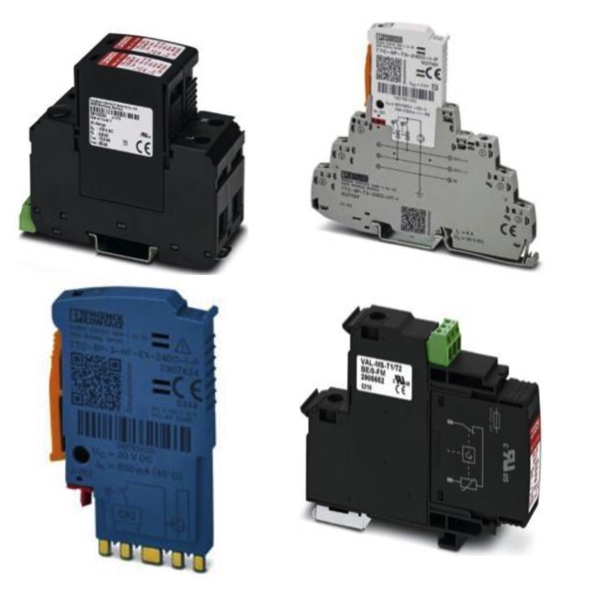Phoenix Contact DC Line Surge Protection

Phoenix Contact DC line surge protection devices are engineered to safeguard equipment and systems operating on direct current by limiting overvoltages and transient energy caused by lightning or switching events. These surge protection solutions are especially important in control cabinets and automation systems where reliable DC power is critical. Phoenix Contact's surge protection components are often used in signal and power lines to provide consistent protection for sensitive electronics and devices that depend on stable DC voltage. The integration of Phoenix Contact DC line surge protection into an industrial system ensures reduced downtime and greater overall reliability.
Phoenix Contact offers a surge protection plug that is designed for efficient removal and replacement, simplifying system maintenance and minimizing service interruptions. The protective circuit within these devices is engineered for optimal energy absorption, delivering consistent performance under a wide range of operating conditions. Whether protecting 24 V DC power supplies or low-voltage signal lines, these surge protection plugs are designed to match various nominal voltage requirements, ensuring compatibility with different industrial and measurement system configurations. Their products can also be integrated with signal interfaces used in information technology environments and other control platforms requiring dependable surge suppression.
More Information about Phoenix Contact DC Line Surge Protection
The Phoenix Contact surge protection product line includes models that are pluggable and can be DIN rail mounted, allowing for quick installation and replacement without requiring extensive rewiring. Some models support impedance-neutral insertion to maintain system stability during transient events, which is particularly useful in sensitive applications involving measurement or communication signals. With a focus on long-term performance and minimal maintenance, Phoenix Contact’s DC surge protection solutions support safe operation in complex environments where equipment must remain protected against unpredictable power disturbances. These devices contribute to system longevity and help engineers meet the rigorous protection demands of modern industrial infrastructure.
FAQs
Does Phoenix Contact's complete product portfolio include a protective plug for MCR applications?
Yes, Phoenix Contact’s complete surge protection portfolio for MCR (measurement and control technology) applications includes protective plugs specifically designed to protect MCR signal circuits, such as the TERMITRAB Complete and PLUGTRAB PT series, which are pluggable and offer integrated status indicators and DIN‑rail mounting.
Surge Protection Basics
What causes power surges?
Lightning strikes are one of the most common causes of power surges and can affect an electrical system even if the strike occurs miles from the electrical source. Conductors buried underground can still transmit the energy of the strike to electrical equipment located indoors. Lightning rods and other grounding equipment can help, but do not completely eliminate the risk.
Switching equipment such as motors, transformers and other equipment can cause a sudden change in load, power loss and disconnection of circuit breakers. This sudden switching can cause overvoltage, leading to power surges. The closer the switching occurs to the electrical system, the more threat it will pose to the equipment.
Operations that a user performs can cause surges, but typically have a very short duration. Examples include: starting a motor, opening circuit breakers and welding equipment.
What is the best way to stop power surges?
By using transient surge suppressors, the problems associated with most transient surges can be eliminated. They provide protection by either blocking or shorting the voltage over its operating limit to ground, protecting circuits downstream of the suppressor. The best way to approach this is in tiers.
Tier 1 – The protection is closest to the incoming power source. This is the main protection for a particular location.
Tier 2 – This is in an area that will be protecting multiple devices that have branch protection. An electrical control panel would be an example of this type of application.
Tier 3 – Individual protection. In the case of an industrial control panel, this would be protection for each instrument entering the panel.

